 Photo of Béisenerbierg menhir;
Credit: Tom Lucas via INRA
Photo of Béisenerbierg menhir;
Credit: Tom Lucas via INRA
Chronicle.lu has teamed up with Luxembourg's National Institute for Archaeological Research (Institut national de recherches archéologiques - INRA) for a series of articles on archaeological digs and discoveries around the Grand Duchy.
The series explores digs spanning from prehistoric to Roman and medieval times, highlighting key finds and what they reveal about Luxembourg’s past. It also sheds light on the work of the INRA and its approach to archaeological and historical research.
The latest article in this series looks at megalithism and the menhir discovered in Reckange in the municipality of Mersch.
Megalithism & Menhirs
More than 5,000 years ago, the first stone structures emerged. In late prehistory (Neolithic Age), between 4500 and 2500 BC, ancient peoples began erecting megaliths (dolmens and menhirs), which are among the oldest known monuments in western Europe.
A menhir is a large upright stone that may be found in isolation or arranged in groups to form rows or alignments, quadrilateral areas, circles or semicircles. They are known to have served several purposes: some were placed to mark burial grounds or for symbolic reasons; others were erected to mark boundaries or travel routes. Some stones were chosen purely for their natural shape, while others were purposely shaped using various techniques (roughening, pecking, shaping, etc.). Statue menhirs (found in regions such as the south of France and Switzerland), consisting of a carved human or humanoid statue engraved with ornaments, weapons and clothing decorated with geometric patterns, are among the earliest representations of the human form. Others were painted, such as those found in Spain or Portugal.
Discoveries & Dating
The earliest evidence of megalithism found in the Luxembourg region dates from the Late Neolithic period, around the early third millennium BC. In the Greater Region (comprising the Saar, Lorraine and the Grand Duchy of Luxembourg), several monuments have been found in Lorraine, Wallonia and the Moselle region of Germany, but there appear to be very few menhirs in Luxembourg.
On the “Béisenerbierg” (Mersch) in 1978, however, Maisy and Robert Weyrich, assisted by Roger Kugener, discovered a large, recumbent stone, only the upper face of which was visible. Believing it to be a menhir, they unearthed a block of sandstone measuring 3 metres in length and weighing 3.5 tonnes that they subsequently moved to an upright position approximately 50 metres from its original location with a view to making further scientific investigation possible.
Modern Excavations
In 2001, archaeological excavations conducted on the original site by the Prehistoric Section at the Luxembourg National Museum of History and Art, under the supervision and direction of François Valotteau, established that the stone had been erected towards the Late Neolithic, more than 4,500 years ago. During the excavations, they uncovered a 65 cm-deep socket (pit) in which the menhir had been held in place by a half-crown of “trig” or “packing” stones. The weight of the menhir had caused it to lean to the side where there was no wedging material and - at some point difficult to specify - fall to the ground. A bracing post was also recovered. This would have been used temporarily to hold in place a piece of timber, possibly to assist when the menhir was originally raised to an upright position.
"Anthropomorphic" Menhir
The Béisenerbierg menhir is made of Luxembourg sandstone, the closest outcrops of which are located more than 2 km to the west of the site where it was erected. The block was shaped by the removal of large flakes of rock to resemble a human (anthropomorphic) form: it has been made narrower in the middle and has the profile of a head. Once shaped, it was moved to and erected in a socket where it was held in place by a half-crown of “trig” or “packing” stones.
One of the First Monuments Discovered in Luxembourg
Although these prehistoric structures can also be found in the regions bordering the country, the Béisenerbierg menhir is the first of its kind to be discovered in the Grand Duchy of Luxembourg. Such monuments may have been erected to mark burial grounds or for symbolic reasons and may therefore have played a role in social or religious gatherings.








